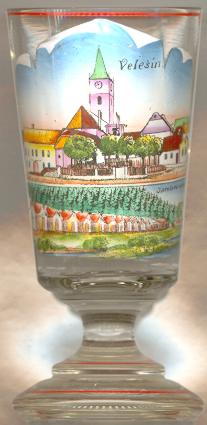

|
| ČESKÁ REPUBLIKA | CZECH REPUBLIC |
| Jihočeský kraj | South Bohemia (České Budějovice) region |
| Okres: Český Krumlov |
 Velešín is situated at an elevation of 548 m in the valley of the
river Malše (Maltsch), about 11 km east of the district town Český Krumlov and
about 16 km south of the regional capital, České Budějovice. The municipality has
a population of about 3,900 (2021).
Velešín is situated at an elevation of 548 m in the valley of the
river Malše (Maltsch), about 11 km east of the district town Český Krumlov and
about 16 km south of the regional capital, České Budějovice. The municipality has
a population of about 3,900 (2021).
The royal castle of Velešín was founded in the first third of the 13th century. The associated village was founded on the opposite side of the river. It was first mentioned in a document in 1265/1266 and obtained the status of a town in 1391. The construction in 1827–1832 of a horse-drawn railway from Linz to Budějovice (extended from Linz to Gmunden in 1842) contributed to economic growth, but the track eventually led through a large bend outside Velešín, which led to a decline in a number of trades. The commissioning of the St. Valentin–Budweis (České Budějovice) railroad in 1871 changed little, since it was essentially laid out on the old horse-drawn tram line. After the founding of Czechoslovakia in 1918, Velešín belonged to the district Český Krumlov. After the Munich Agreement (1938), Velešín remained with Czechoslovakia and between 1939 and 1945 was part of the Political District of Budweis in the Protectorate of Bohemia and Moravia. In the 20th century, the deeply incised meandering valley of the Malše became a destination for recreation, until the valley was flooded in the 1970s by the construction of a dam in Římov. In 1996, Velešín regained the status of a town.
The former  church of St. Philip and St. Jacob [top]
dates from the 15th century. It was closed in 1785 during the Josefine reforms, sold to the village
and rebuilt into appartments. As an exceptional example of the use of the abolished church building for residential purposes with a combination
of late Gothic and Classicist architecture, it was inscribed on the list of cultural monuments in 1958.
church of St. Philip and St. Jacob [top]
dates from the 15th century. It was closed in 1785 during the Josefine reforms, sold to the village
and rebuilt into appartments. As an exceptional example of the use of the abolished church building for residential purposes with a combination
of late Gothic and Classicist architecture, it was inscribed on the list of cultural monuments in 1958.
[https://de.wikipedia.org/wiki/Vele%C5%A1%C3%ADn, https://en.wikipedia.org/wiki/Vele%C5%A1%C3%ADn, https://cs.wikipedia.org/wiki/Vele%C5%A1%C3%ADn;
https://cs.wikipedia.org/wiki/Kostel_svat%C3%BDch_Filipa_a_Jakuba_(Vele%C5%A1%C3%ADn)]
![[scale]](lineal.jpg)